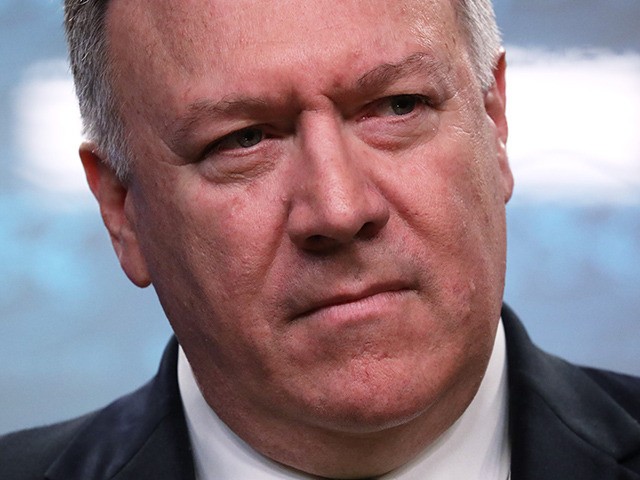American Secretary of State Mike Pompeo accused the Communist Party of China on Wednesday of destroying samples of the Wuhan coronavirus collected early, making it far more difficult for scientists to trace the virus’s evolution or find its origin.
Pompeo’s accusation follows months of reports similarly indicating that officials at China’s National Health Commission instructed laboratories nationwide to destroy viral samples used to sequence the coronavirus’s genome, or identify it as a new type of virus separate from other coronaviruses such as the one that causes Sudden Acute Respiratory Syndrome (SARS).
Pompeo was speaking at a press conference in which he explained the reasoning behind the Trump administration withholding funds to the World Health Organization (W.H.O.), until an investigation occurs into how it allowed China to actively hinder attempts to contain what became a pandemic.
“We strongly believe that the Chinese Communist Party did not report the outbreak of the new coronavirus in a timely fashion to the World Health Organization,” Pompeo told reporters. “Even after the CCP did notify the W.H.O. of the coronavirus outbreak, China didn’t share all of the information it had. Instead, it covered up how dangerous the disease is.”
“It didn’t report sustained human-to-human transmission for a month until it was in every province inside of China. It censored those who tried to warn the world, it ordered a halt to testing of new samples, and it destroyed existing samples,” Pompeo continued. “The CCP still has not shared the virus sample from inside of China with the outside world, making it impossible to track the disease’s evolution.”
Viruses can evolve very quickly, changing characteristics as they jump from person to person. The viral samples from patients in the United States may vary significantly from those in China or any other part of the world. Comparing them to early samples of the virus from China, however, is not possible anymore, Pompeo explained, as those samples do not exist.
Pompeo appeared to be confirming reports that first began circulating in February that the Chinese Communist Party actively destroyed scientific materials that could have helped the world better understand the Chinese coronavirus. In early February, the independent Chinese outlet Caixin Global cited an epidemiologist with sources in Wuhan who lamented that the Party had “disinfected” Wuhan’s notorious wet market, initially believed to be the origin of the virus. That month, Chinese officials claimed that the virus had infected humans from interaction with, and possibly consumption of, wild animal meat purchased at that market.
China shut down the market on January 1, according to early reports, and decontaminated the site, thereby destroying any biological samples scientists could have had access to.
“There’s no way for anybody to do the research to figure out where (the virus) came from,” epidemiologist Walter Ian Lipkin told the outlet. “We don’t have the information required to pinpoint it.”
China has since claimed a “study” showed the virus did not originate in the market at all and has promoted the unsubstantiated conspiracy theory that the U.S. Army manufactured the virus.
Later that month, Caixin published a report stating that samples of the virus existing in Chinese laboratories – presumably the only existing ones since those potentially at the market were no longer available – had been destroyed. According to the Caixin report:
On Jan 1, after several batches of genome sequence results had been returned to hospitals and submitted to health authorities, an employee of one genomics company received a phone call from an official at the Hubei Provincial Health Commission, ordering the company to stop testing samples from Wuhan related to the new disease and destroy all existing samples.
The employee spoke on condition of anonymity, saying the company was told to immediately cease releasing test results and information about the tests, and report any future results to authorities.
Then on Jan 3, China’s National Health Commission (NHC), the nation’s top health authority, ordered institutions not to publish any information related to the unknown disease, and ordered labs to transfer any samples they had to designated testing institutions, or to destroy them. The order, which Caixin has seen, did not specify any designated testing institutions.
Reports from some of these labs that the virus may have been related to SARS resulted in some on social media – notably, doctors in Wuhan – sharing tips on how to prevent contracting a communicable disease. China responded to those posts by arresting and disappearing the doctors. One of those doctors, Li Wenliang, later died after the Chinese government claimed he tested positive for the virus.
Legislation proposed by Sen. Tom Cotton (R-AR) and Rep. Dan Crenshaw (R-TX) that would allow American citizens to sue China in American courts for damages related to the Chinese coronavirus also notes evidence that the virus samples were destroyed before international scientists could study them.
In his remarks Wednesday, Pompeo condemned the World Health Organization for not responding negatively to the clear signs that Chinese officials were hiding pivotal evidence to containing the virus.
“Not making a legal determination here today on China’s adherence to the IHRs [International Health Regulations], but the World Health Organization’s regulatory arm clearly failed during this pandemic,” Pompeo said, noting that some of those regulations demanded, among other things, prompt reporting of the outbreak and “any unusual or unexpected public health events such as SARS.”

COMMENTS
Please let us know if you're having issues with commenting.